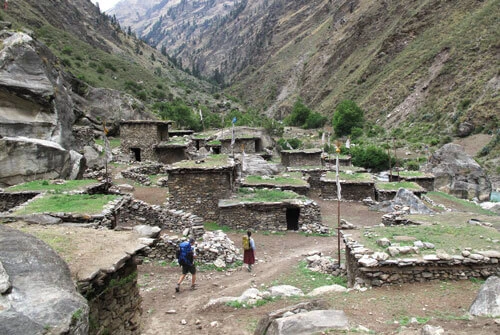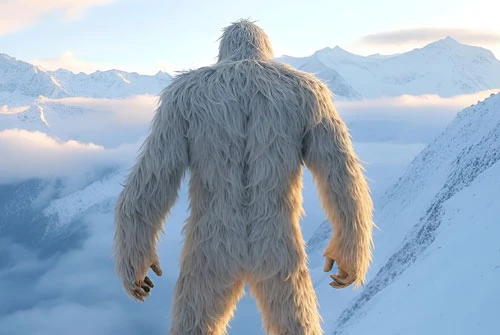Visit Upper Mustang For:
- Fascinating History
- Exceptional Topography
- Unique Culture and People
- Ruined Forts, Impressive Hills, and Houses:
- Amazing Attractions:
- Sky Caves.
- Ancient Chortens.
- Prehistoric Monasteries.
- Royal Palaces
Fascinating History
Upper Mustang has a rich history buried in legends and myths. To the local inhabitants of Mustang, this barren rain shadow, Tibet-like region is 'Lo'. Legends state that Ame Pal, the first king of Lo, founded Mustang in the early 14th century. He built the Walled City of Lo during the same period, which is now very popularly known as Lo-Manthang.
This city is considered to be the best-preserved 'Medieval Walled city’ in the world. History states that this enormous wall around the palace was built for security and to separate the Royals from non-royals. Jigme Dorje Palbar Bista was the last king of Lo, and was the direct 25th descendant of Ame Pal, who died at the age of 86 on the 16th of December 2016.
THE FACT:
During the Shah rule in Nepal, King Prithvi Narayan Shah in the 18th century began to consolidate Nepal into one. During this time, the Gorkha Army never actually seized Mustang; they recognized the rule of the Mustang king. However, in the course of time, Mustang became a part of Nepal, yet the King retained his title and Mustang maintained its sovereignty.
Mustang or Lo was an independent state until 1951. However, during the rule of King Tribhuvan Shah, Mustang was consolidated further into Nepal. As per the agreement, the king of Mustang was automatically granted the honorary rank of Colonel in the Nepalese Army.
With the Chinese invasion of Tibet in the 1960s, Mustang became the center for ferocious Tibetan guerrilla soldiers known as ‘Khampas’. The secret operation of Khampas in Lo fighting against the Chinese ended sometime around the 1970s. Though after obtaining special permission, many travelers visited Upper Mustang, but this forbidden Kingdom started allowing legal foreign trekkers in March 1992.
It is still a restricted area for which foreigners require special permits from the immigration office of Nepal. The book ‘Mustang – The Forbidden Kingdom’ by Michel Peissel caters to anyone with vivid information about Upper Mustang.
Special Topography:
Upper Mustang has been proven to be underwater for many years, and with the folding of the mountain, the water shifted further South. So the landscape formation in Upper Mustang looks much like a dried-out ocean. It's arid, dry, and very strong wind howls through the valley almost all through the year.
Being a rain shadow area, Mustang receives very little or no rain than to the rest of the areas of Nepal. However, it snows in winter. Being a rain shadow area, Mustang has always been a great place to trek during the monsoon in Nepal. The hills around Mustang are very picturesque and colorful. The enormous wind-eroded hills stand resilient with unique designs that are simply phenomenal.
Upper Mustang is a source of the river Kali Gandaki, which is older than the Himalayas, 80 million years old. Kali Gandaki further cuts the valley to the south of Nepal, forming the valley as the World’s Deepest Gorge. Besides, the Kali Gandaki Route served as a significant route during the Salt Trade Era between Tibet and Nepal. The water resources at an interval of a couple of hours' distance gave way to beautiful human settlements that look like a mirage in the desert.
Unique Culture and People:
In this region of 'The Lost Tibetan Kingdom’, one can observe the interesting influence of Tibetan Buddhism. The abundant spiritual ancient Chortens, Prayer walls, paintings, and monasteries sincerely demonstrate the Tibetan Buddhism influence. Significantly, this route has been used by the Indian saint Guru Padmasambhava (750 – 810 AD) to reach Tibet.
Guru Padmasambhava, also known as Guru Rimpoche, was the founder of now Tibetan Buddhism. He created a fusion between Buddhism with the original Shamanistic Tibetan religion of 'Bon'. This fusion is the reason why Tibetan Buddhism is so fascinating. His image, idol, or painting is almost everywhere in the monasteries, shrines, or homes of Mustang. Guru Rimpoche built the first-ever Tibetan Buddhist monastery, GHAR GOMPA (Gumba) in the 8th century, and it now happens to be the oldest in the world.
The people of Upper Mustang call themselves Lobas, which signifies the ‘people of Lo’. They are the people famous for their hard work and trade efficiency. Besides, they are peace-loving people who always bear beautiful smiles on their faces. The practice of Polyandry was popular among the inhabitants of Mustang – but not anymore.
Though time and again there have been external influences, yet the people of Mustang have managed to retain their culture very well. Every year in the month of May, Mustang celebrates one of its major festivals called the Tiji Festival. It’s a prayer for ‘Peace’. Both local and international tourists visit Upper Mustang during this festival.
Ruined Fortress, Impressive Hills, and Houses:
Furthermore, over every settlement, you would see plenty of ruined forts. Over the hill ridges, you would witness the remains of forts and watch towers, which explain that for some time, Mustang had numerous constituencies. Each constituency was highly fortified by its armies and these watch towers. Trekking high up to these hills and visiting these forts is very sensational.
The landscapes in the upper Mustang are more like the Grand Canyon in Arizona. Among the multi-color hills, some of the hills are blood red and some blue. It is very true that the people of Mustang paint their houses with the natural color paint that they get from these hills.
The houses in Upper Mustang are made from sun-baked mud bricks, rocks, and willow wood pillars. The crafting of all these houses is so amazing that each of the Mustang villages exists like an amusing maze. It’s a sensational experience to go around these ancient villages. Their structure makes the whole of Mustang look very primitive yet very enchanting. The medieval city of Upper Mustang, with all these, is simply mesmerizing. All this clearly verifies an answer to the question of why visit Upper Mustang now. It is indeed a once-in-a-lifetime experience.
‘The Lost Tibetan Kingdom of Mustang’ – soon it will be lost forever.
Amazing Attractions:
Entry to Upper Mustang itself is very dramatic as you fly through the World’s Deepest Gorge, Kali Gandaki. This short flight is spectacular with the view of the World’s highest peaks of Annapurna and Dhaulagiri. We land in the beautiful town of Jomsom, the administrative center of Mustang and popularly known as the ‘Windy Valley of Nepal’. The scenic Nilgiri range dominates the town of Jomsom which is simply remarkable. Visit Upper Mustang for the following significant attractions.
Sky Caves:
As we enter the restricted area of Mustang and trek into its amazing valley we witness ample sky-high colorful cliffs at its best. These cliffs are riddled with amazing Sky Caves. Some of these CAVES date back over 3,000 years. Legend has it that Lo-Manthang sustains more than 10,000 sky caves carved into these high cliffs. These caves give you an account of prehistoric human settlements.
During the early years, they were used as Homes, later burial chambers, then space for enlightenment, and now they are used as shrines or tourist attractions. Moreover, some of these caves bear prehistoric paintings of immense worth. The Jhong Sky Cave in Chhosar is fascinating and has about 42 compartments where ancient Tibetans lived thousands of years ago.
Ancient Chortens:
Every settlement of Upper Mustang is marked by ancient Chortens (spiritual monuments). Every now and then we encounter dramatic Chortens designed with different patterns, symbols, and colors. The village of Tsarang is famous as the 'land of Chortens'. They have great symbolic significance and some of these stands over 30 feet tall. We come across to these mystical Chortens right from the very first day we get to Jomsom. However, there is variation in terms of size and color that signifies diverse religious values.
Prehistoric Monasteries:
Being a land of real Tibetan Buddhism, Upper Mustang delivers abundant ancient monasteries. It’s a place where we find the oldest Tibetan monastery in the world, Ghar Gompa built in the 8th century by Guru Rimpoche or Guru Padmasambhava. The monasteries built almost all over the upper Mustang bear ancient relics and paintings of great religious value. Most of these date back to the 13th century. They exhibit prehistoric paintings and mandalas that demonstrate the skills of Classical Tibetan Monastic Architecture of the Sakyapa.
This Classical Tibetan era was indeed one of the most distinguished periods in the history of Tibetan Artistry. However, due to the poor roofing of these ancient monasteries, the priceless paintings are being washed off by rain and leakage. So for the last many years restoration of these paintings has been going on in Upper Mustang.
Besides all these, the 4 storied palaces in Lo-Manthang, the king’s summer palace in Thinggar, and the palace of Tsarang are of great significance. They established great architectural craftsmanship of that age.
UPPER MUSTANG PERMITS:
The formidable kingdom of Lo, Upper Mustang, is a restricted area, located in the remote Himalayan region of Nepal. Since Upper Mustang was open to the outside world in 1992, only a small number of treks are permitted each year which makes it a very exclusive trekking destination.
Being a restricted area there are few restrictions and limitations for Foreign Trekkers.
- First, Foreign Trekkers are forbidden to trek alone, and Nepal immigration doesn’t issue special permits for just one traveler – the minimum no of foreign travelers must be at least 2.
- Second, all foreign trekkers must be affiliated with a local travel company to visit Upper Mustang. If you book through any of the local travel agencies, they will arrange everything for you.
- Finally, the SPECIAL PERMITS.
Permits required for the Upper Mustang trek include:
RESTRICTED AREA PERMIT: All trekkers require a Special Trekking Permit, which costs $500 per trekker and is issued by the Nepal Immigration office. The most crucial thing to know is, that special permits are only issued for a minimum of 10 days of permit validity; you can extend through but you can't lessen the minimum number of days.
This literally means that even if you travel to Upper Mustang for 5 days, you will still need a 10-validity permit that costs you $500. If by any chance you wish to extend your days in Upper Mustang past 10 days then an additional $50 per day per trekker will be charged.
ACAP PERMIT: Additional permits are required, an ACAP (Annapurna Conservation Area Project) permit, since Upper Mustang falls within the Annapurna Conservation Area; you would require the national park permit.
Next is the TIMS (Trekking Information Management System) permit (NOT MANDATORY AS OF NOW) – together, ACAP and TIMS will cost you an extra $50 per trekker. The number of days for these permits is not restricted to the limited number of days like Special permits. All of this, however, will be organized by Nepal Pyramids prior to your arrival in Kathmandu.






